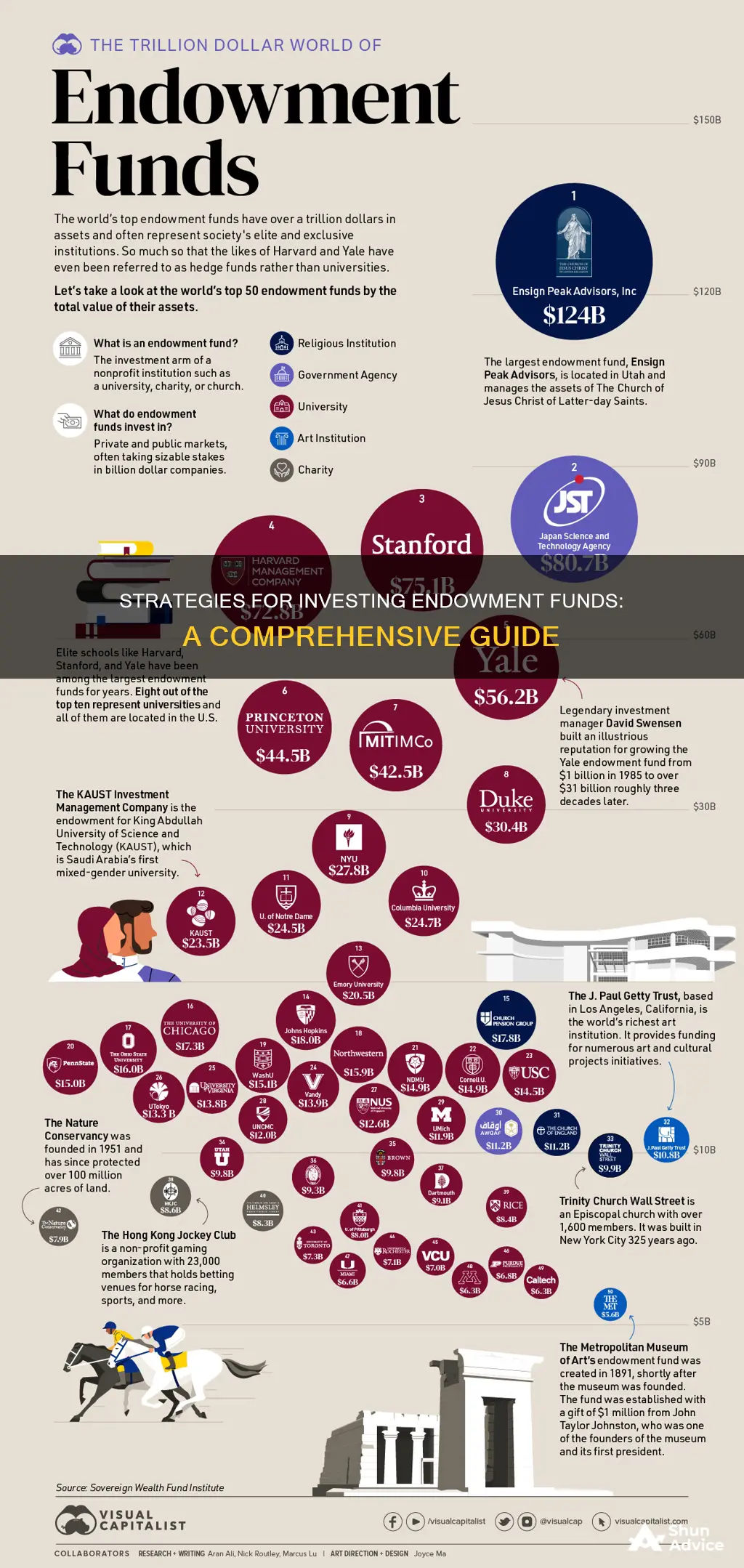
Endowment funds are a way for non-profits to set aside funds for the future. They are typically established as trusts, with the initial capital coming from donations, and are used to fund charitable and nonprofit institutions such as universities, hospitals, and churches. The funds are invested in a variety of assets, including cash, equities, bonds, and other securities, with the goal of generating investment income. The primary objective of endowment funds is to maintain the corpus in perpetuity, while also growing it at a rate that outpaces inflation. This allows the nonprofit to use the annual investment income for programs, operations, or other specified purposes, without dipping into the principal amount.
| Characteristics | Values |
|---|---|
| Initial capital | Donations |
| Purpose | Funding charitable and nonprofit institutions such as churches, hospitals, and universities |
| Structure | Intact principals and investment income available for use |
| Types | Term endowment, restricted and unrestricted endowment, and quasi-endowment funds |
| Investments | Cash, equities, bonds, and other types of securities that can generate investment income |
| Beneficiary | A non-profit organization |
| Principal value | Kept intact |
| Investment income usage | Can be used for certain purposes |
| Investment policies | Outline the types of investments that the fund manager is allowed to make |
| Withdrawal policies | Limit the amount of money that the organization can take out of a fund within each period |
| Usage policies | Determine what the fund can be used for, e.g. scholarships, scientific research, public services, and other charitable activities |
What You'll Learn
- Endowment funds are typically invested in cash, equities, bonds, and other securities
- Endowment funds are established to fund charitable and nonprofit institutions
- Endowment funds are usually independent trusts
- Endowment funds are subject to investment and withdrawal policies
- Endowment funds can be permanent or quasi-endowments

Endowment funds are typically invested in cash, equities, bonds, and other securities
Endowment funds are a gift to a non-profit organisation, typically a university, hospital, or charity. They are usually funded by donations and are designed to be invested to generate future income. The principal value of an endowment fund is usually kept intact, while the investment income can be used for certain purposes.
Endowments tend to allocate the largest percentages of their portfolios to alternative asset classes such as hedge funds, private equity, venture capital, and real assets like oil and other natural resources. These alternative investments often outperform traditional stocks and bonds but have longer gestation periods and higher minimum investment requirements.
Endowments also invest in domestic and international stocks and bonds, foreign developed market stocks, emerging market stocks, real estate, commodities, managed futures, debt-driven instruments, and other diversifying assets. By diversifying their portfolios across multiple asset classes, endowments aim to generate strong returns with lower portfolio volatility.
The investment strategies of endowments are typically managed by investment committees, which may include university alumni. These committees determine the asset allocation models and ensure that the investments align with the endowment's objectives and guidelines.
Hedge Fund Managers: Why Shun Sustainable Investing?
You may want to see also

Endowment funds are established to fund charitable and nonprofit institutions
Endowments are a way to set aside funds for the future and can be an important strategy for financial sustainability. They are designed to keep the principal amount, or "corpus," intact while allowing the interest earned to be used for the endowment's specified purpose. This can include funding operations, programs, scholarships, research, or other charitable activities.
The management of endowment funds involves creating an investment strategy to grow the fund and generate sustainable income. This usually involves investing in equities, bonds, or alternative assets such as hedge funds, private equity, venture capital, or real estate. The investment strategy is typically guided by an investment committee and can vary depending on the size of the endowment and the specific goals of the organisation.
Endowment funds have three main components: an investment policy, a withdrawal policy, and a usage policy. The investment policy outlines the types of investments and risk levels permitted. The withdrawal policy establishes the amount that can be withdrawn from the fund at regular intervals, usually based on the organisation's needs and the fund's performance. The usage policy defines the purpose of the fund and ensures that grants are aligned with this purpose.
Overall, endowment funds play a crucial role in supporting charitable and nonprofit institutions by providing a sustainable source of income and enabling them to carry out their missions effectively.
Strategies for Picking a Hedge Fund to Invest In
You may want to see also

Endowment funds are usually independent trusts
Endowment funds are usually established as independent trusts, which means they are separate from the organisations they support. This is done to ensure that the funds are used for their intended charitable purposes.
Endowment funds are typically set up to support non-profit organisations and activities, such as universities, hospitals, and charities. The funds are often established with intact principals, meaning that the principal value is kept intact and not used for the daily operations of the organisations they support. Instead, the investment income generated by the endowment is available for use by the supported organisation.
The donors who initially invest in the endowment fund for charitable purposes usually restrict the usage of the funds. For example, a donor may provide capital to an endowment fund with the intention to exclusively save animals. In such cases, the endowment fund is known as a restricted endowment. On the other hand, unrestricted endowments allow the recipient organisation to spend the money for any purpose. Unrestricted endowments are less common than restricted ones.
Endowment funds are typically subject to investment policies that outline the types of investments the fund manager is allowed to make. These policies may cover asset allocation, risk level, and targeted return, among other factors. Endowment funds usually have a lower risk level and more liquidity concerns than other types of investment funds, such as mutual funds and hedge funds.
The independent nature of endowment funds as trusts helps to ensure that the funds are managed and utilised effectively and properly, in alignment with the intentions of the donors and the needs of the supported organisations.
Understanding 401(k) Investment: Timing Your Retirement Savings
You may want to see also

Endowment funds are subject to investment and withdrawal policies
Investment Policies
Endowment funds typically have investment policies that outline the types of investments allowed and the level of risk that can be taken. These policies are designed to balance risk and return, aiming for long-term sustainability. The policies may cover asset allocation, risk levels, and targeted returns. For example, endowment funds often invest in alternative asset classes like hedge funds, private equity, and real assets. They usually carry lower risk levels and have more liquidity concerns than mutual funds or hedge funds. The liquidity requirement ensures cash is available for withdrawal when needed.
Withdrawal Policies
Withdrawal policies place limits on the amount of money that can be withdrawn from the endowment fund within a specific period. The annual withdrawal is typically capped at a low percentage, such as 4-5%, to ensure the fund's longevity. The withdrawal policy can be based on the organisation's needs and the fund's size, with most endowments having an annual withdrawal limit. For instance, an endowment might restrict withdrawals to 5% of the total fund value.
Usage Policies
Usage policies dictate the purposes for which the endowment fund can be used. These policies ensure that the funds are utilised effectively and appropriately. Endowments can be used for various purposes, including scholarships, scientific research, public services, and other charitable activities. In the case of university endowments, they may be used to fund specific departments, provide financial aid to students, or endow professorships.
Guidelines and Restrictions
Endowment funds often have guidelines and restrictions in place to ensure compliance with donor wishes and to maintain the integrity of the fund. These guidelines may include restrictions on the use of the principal amount, allowing only the investment income to be spent. In some cases, only a certain percentage of the endowment's assets can be used annually, and the ratio of principal to income can vary based on market rates. Withdrawing from the principal amount is typically prohibited without specific authorisation and may require court approval.
Long-Term Focus
Endowment funds are designed with a long-term focus, aiming for sustainability and growth over time. The investment strategies and withdrawal policies are crafted to ensure the funds can meet their objectives and support their designated causes for the long term.
Nas' Venture Capital: Where Does He Invest?
You may want to see also

Endowment funds can be permanent or quasi-endowments
Endowment funds are a great way to set aside funds for the future and are a hallmark of financial sustainability. They are typically used by large institutions, such as universities and hospitals, but can also be beneficial for any charitable nonprofit's financial management and revenue strategy.
On the other hand, quasi-endowments are funds offered to an organisation with a specific purpose from its donor, usually an individual or board of directors. Quasi-endowments are similar to standard endowments, but with one major difference: the principal is not held permanently. The principal of a quasi-endowment fund may be distributed at a later date for general spending purposes. The board of directors holds the authority to terminate restrictions on financial access to the principal and allow distribution for a range of purposes. Quasi-endowments are established using either donor funds (such as unrestricted bequests) or institutional funds (typically excess operating support and revenue).
The key differences between endowment funds and quasi-endowment funds include the following: endowment funds distribute from net income, mainly income and dividends; quasi-endowment funds distribute annually based on market value percentages. Endowment funds are permanent, while quasi-endowment funds are not, and a future board could vote to remove part or all of the principal for spending.
Schwab S&P 500 Index Fund: A Smart Investment Choice
You may want to see also
Frequently asked questions
An endowment fund is an investment portfolio with the initial capital deriving from donations. Endowment funds are established to fund charitable and nonprofit institutions such as churches, hospitals, and universities.
Term endowment, restricted and unrestricted endowment, and quasi-endowment funds are some types of endowment funds.
Endowment funds are initially invested by donors for certain charitable purposes. They are usually established as trusts, which keep them independent of the organizations that they support. Endowment funds consist of cash, equities, bonds, and other types of securities that can generate investment income.
The major difference between an endowment fund and a typical investment fund is that the beneficiary of an endowment fund is a non-profit organization instead of individual investors. Typically, the principal value of an endowment fund is kept intact, while the investment income can be used for certain purposes.
Endowment funds offer several advantages, including tax benefits for donors, the ability to support charitable causes, and the potential for long-term financial stability for the organizations they support.







